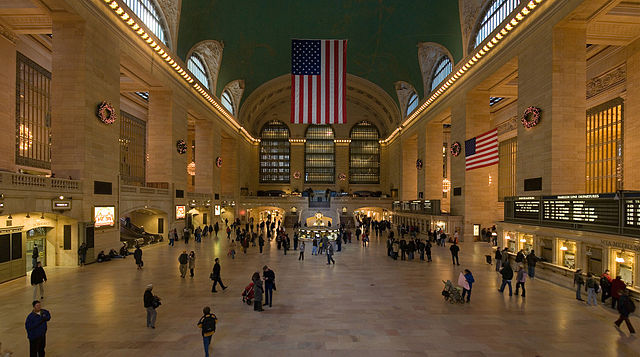Few train stations have captured the imagination more than New York’s Grand Central Terminal (commonly known as Grand Central Station), which, 100 years after its opening, remains one of the world’s most visited landmarks. More than 20 million people pass through the Beaux-Arts building each year — many of whom do not have tickets or travel plans, but simply want to see the grandeur of the legendary station and experience a New York icon.
Born of Necessity
Grand Central Station was not always the elegant building we see today. In fact, the station as it stands now is actually the third version of a train station on this site. The first station, Grand Central Depot, was built to consolidate the three train lines running into New York at the time. While the station was innovative for the late 1800s, with platforms raised to the height of the train cars and covered tracks, the baggage transfer area was chaotic on the best days, and limited space meant that train turnaround times were slow.
To alleviate the congestion in the train yard and streamline operations, the station was reconstructed and reopened in 1900 as Grand Central Station. However, ever-increasing rail traffic and developments in transportation — including the ability to electrify the rails — made it clear that more changes were necessary.
The most significant development in the history of Grand Central was the idea that the rail lines could be buried under the streets of Manhattan. Rather than take up valuable real estate with the terminal, tracks and train yard, the trains could run through tunnels under the city, freeing up valuable space for other development. The reconstruction of the new Grand Central Terminal was completed in 1913, paving the way for one of the biggest construction booms in New York City history — a boom that included the construction of the Chrysler Building in 1920, forever altering the Manhattan skyline.
Grandeur and Decay
Grand Central Station is a marvel of Edwardian design, with details inspired by New York’s Golden Age. From the wide marble staircases modelled on those at the Paris Opera House to the iconic clock with an opal face valued at more than $20 million, the entire building reflects the elegance and refinement that was the hallmark of New York’s upper class at the turn of the 20th century.
However, Grand Central did not retain its refined elegance. The Great Depression, World War II and a decline in railroad traffic, thanks to the expansion of air travel and the U.S. highway system, meant that Grand Central fell into disrepair. By the 1960s, the station was better known for its large population of vagrants than for its beauty and design. Even the soaring ceiling, once painted with a vision of the night sky (astute observers noticed that the constellations were painted backwards, leading John Vanderbilt to declare that the painting was to be viewed from the perspective of God), was covered with a layer of grime so thick it obscured the design.
At the time, the station was owned by the Penn Central Railroad, which announced plans to demolish the station and build a large tower in its place. Public outcry and a court case followed, with the result a declaration of Grand Central’s status as a historic landmark.
Return to Glory
In the 1980s, preservationists began a large-scale restoration project to return Grand Central to its former grandeur. The 12-year project included cleaning the building and restoring the Main Concourse ceiling, as well as building an additional grand staircase using marble from the same quarry as the original staircase. The iconic arrival/departure display board was replaced with an electronic board that maintained the same style as the original Omega board, setting the stage for other modernisations that maintained the original character of the station. Among the details that were preserved were the many oak leaf and acorn motifs that adorn the building, symbols of the Vanderbilt family who financed much of the original construction.
While Grand Central is no longer a hub to other cities in the U.S. — Amtrak stopped service in 1991, and the station is now primarily used by commuters from Long Island and Connecticut — it still attracts visitors who want to shop, dine and explore the building. With a wealth of secrets (including a hidden track only used for transporting the President of the United States out of the city in an emergency) Grand Central Station is, in many ways, the keeper of New York’s modern history.








Leave a Reply